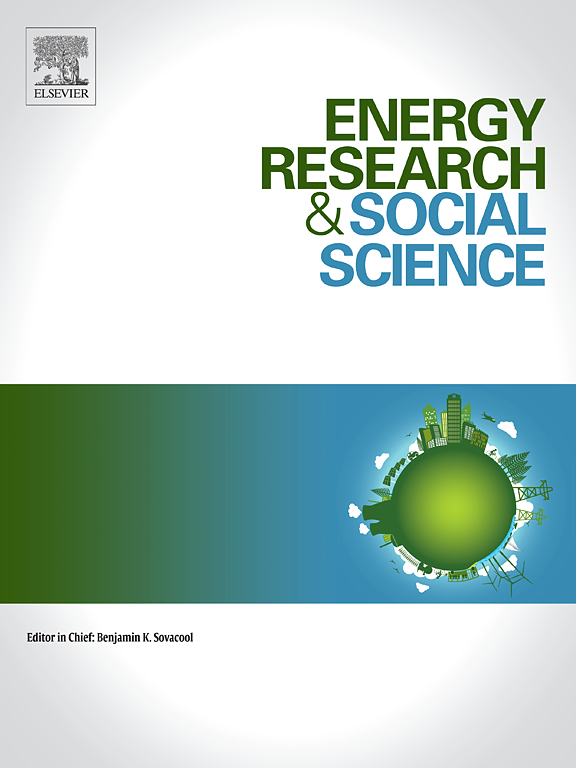建造还是购买?挪威配电网灵活性服务的市场化
IF 7.4
2区 经济学
Q1 ENVIRONMENTAL STUDIES
引用次数: 0
摘要
预计电网将在能源转型中发挥关键作用,作为吸收其他部门转型影响的促进者。本文探讨了如何通过建立本地灵活性市场来交易终端用户灵活性来解决电网容量紧张的挑战。使用将市场视为框架的市场制造方法(Callon, 2016年,2021年),我们研究了挪威可将灵活性作为服务出售给配电网的条件的构建。分析的实证材料包括对2020 - 21年专业人士的采访以及挪威智能电网会议(2020 - 2022)的观察结果。我们的分析侧重于寻求为市场交易创建新框架的选定过程,包括如何通过构建测量安排将灵活性框架化为“明确的”商品;配电网公司如何被定位为需要灵活性的买方,并能很好地评估和利用灵活性;以及框架如何使灵活性与网格升级相媲美。我们发现,这些框架过程试图吸引和改变大量行为者来构建灵活性的评估安排。我们将讨论如何构建灵活性,以实现灵活性对网格的主动影响,并确保灵活性激活在其他方面是被动的。我们得出的结论是,将灵活性市场化最好不是理解为释放巨大的、预先存在的资源,而是将参与者和社会物质安排转变为将灵活性塑造成一种广泛的参与者可以评估的可知对象的过程。本文章由计算机程序翻译,如有差异,请以英文原文为准。
To build or buy? Marketization of flexibility services in the Norwegian distribution grid
Electricity grids are expected to play a key role in energy transitions as facilitators that absorb the impacts of transitions in other sectors. This article examines how challenges with strained grid capacity are addressed through making local flexibility markets for trading end-user flexibility. Using the markets-in-the-making approach that conceives markets as framings (Callon, 2016, 2021), we examine the construction of conditions in which flexibility could be sold as a service to distribution grids in Norway. The empirical material analyzed consists of interviews with professionals in 2020–21 and observations from Norwegian Smart Grid Conferences (2020−2022). Our analysis focuses on selected processes seeking to create new frames for market transactions, including how flexibility is framed as an ‘explicit’ good by constructing measurement arrangements; how distribution grid companies are framed as buyers who need flexibility and can evaluate and use the flexibility good; and how framing seeks to make flexibility comparable with grid upgrades. We find that these framing processes seek to engage and transform a large number of actors to construct the evaluation arrangements for flexibility. We discuss how flexibility is framed to enable the articulation of flexibility's active impact on the grid and also to assure that flexibility activation is passive in other respects. We conclude that marketizing flexibility is not best understood as unlocking a vast, pre-existing resource but rather as a process of transforming actors and sociomaterial arrangements to shape flexibility into a knowable object that a wide array of actors can evaluate.
求助全文
通过发布文献求助,成功后即可免费获取论文全文。
去求助
来源期刊

Energy Research & Social Science
ENVIRONMENTAL STUDIES-
CiteScore
14.00
自引率
16.40%
发文量
441
审稿时长
55 days
期刊介绍:
Energy Research & Social Science (ERSS) is a peer-reviewed international journal that publishes original research and review articles examining the relationship between energy systems and society. ERSS covers a range of topics revolving around the intersection of energy technologies, fuels, and resources on one side and social processes and influences - including communities of energy users, people affected by energy production, social institutions, customs, traditions, behaviors, and policies - on the other. Put another way, ERSS investigates the social system surrounding energy technology and hardware. ERSS is relevant for energy practitioners, researchers interested in the social aspects of energy production or use, and policymakers.
Energy Research & Social Science (ERSS) provides an interdisciplinary forum to discuss how social and technical issues related to energy production and consumption interact. Energy production, distribution, and consumption all have both technical and human components, and the latter involves the human causes and consequences of energy-related activities and processes as well as social structures that shape how people interact with energy systems. Energy analysis, therefore, needs to look beyond the dimensions of technology and economics to include these social and human elements.
 求助内容:
求助内容: 应助结果提醒方式:
应助结果提醒方式:


